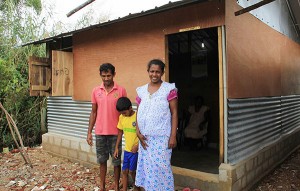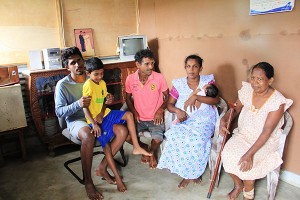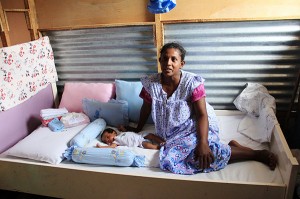Shelter for Ms.Swarnakanthi’s family

Swarnakanthi, Priyantha and their second son outside their new shelter
In May 2016, extreme weather conditions caused by cyclone Roanu resulted in severe floods and landslides in Sri Lanka. The disaster affected approximately 500,000 people in 25 Districts, resulting in 93 deaths, while 6,382 houses were fully damaged and 25,958 houses were partially damaged. The Districts of Colombo, Gampaha and Ratnapura were the most affected by the floods, while Kegalle district was affected by several landslides.
In response to this crisis, UN-Habitat is providing relief assistance to affected communities in Colombo and Gampaha districts in the Western Province through the project “Emergency Shelter Relief for Flood Affected Families in Colombo and Gampaha Districts in Western Province, Sri Lanka”. The project is funded by the United Nations Central Emergency Response Fund (CERF) with additional funding from UNHCR and the Government of Switzerland.
This project is addressing several CERF life-saving criteria for affected people including the provision of transitional shelters, essential Non Food Items (NFIs), repair of wells and toilets and cleaning of canals. In Gampaha district, 74 families are being provided transitional shelters. Mrs. Swarnakanthi’s family from Nilsirgama village was provided with a shelter as their home had been badly damaged by the floods.
Nilsirigama is a Grama Niladhari division in Wattala DS division in Gampaha district consisting of 300 families. It is surrounded by marshy land and several waterways including the Ja-ela canal and Dandugama river. The flooding had affected 300 families, nearly 1,200 people, in the village. Many of the flood affected families lived in temporary relief camps and in schools and churches until the flood waters subsided. Despite the dangers of the flood, some male members of families stayed behind to protect their belongings.
Mrs. Swarnakanthi, her husband, mother and two sons had lived in their house in Nilsirigama GN Division for the past three years. Their house is located in a marshy area with several canals located nearby. Their house, constructed mainly with planks, could not withstand the intensity of the flood. The house was flooded with four feet of water and many of their belongings including clothes were destroyed. The narrow pathway to the house was also completely inundated by the floods making access dangerous, especially for Swarnakanthi who was 4 months pregnant at the time of the disaster. As the flood had made their home uninhabitable, the family moved to a relief camp in Colombo.

The family relaxing in their living space

Swarnakanthi with her baby in their bedroom
Mrs. Niranji, Grama Niladhari of Nilsirigama said “We are grateful to the donors and UN-Habitat for helping our village. Many families like Swarnakanthi’s find it difficult to deal with external shocks like natural disasters as the family doesn’t have a regular household income or savings. Swarnakanthi was very vulnerable at this time as she was pregnant during the time of the disaster. I am very grateful to all the project partners for this timely support.”
The CERF project is being implemented by UN-Habitat in the districts of Colombo and Gampaha from June 2016 – February 2017. The project aims to assist 130 families with transitional shelters. Overall, 85,500 people will benefit from this project through numerous interventions including repair of wells and toilets, NFIs and canal cleaning. UN-Habitat is implementing this project in close collaboration with the Government of Sri Lanka and several partners – the Rural Development Foundation (RDF), the Sri Lanka Red Cross Society (SLRC) and Sri Lanka Land Reclamation & Development Corporation (SLLR&DC).
